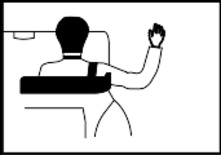 Victorian Consolidated Regulations
Victorian Consolidated Regulations Victorian Consolidated Regulations
Victorian Consolidated Regulations(1) To give a hand signal for stopping or suddenly slowing, the driver must extend the right arm and hand at right angles from the right side of the vehicle, with the upper arm horizontal and the forearm and hand pointing upwards, and with the hand open and the palm facing the direction of travel.
(2) However, the rider of a motor bike may give the hand signal by extending the left arm and hand at right angles from the left side of the motor bike, with the upper arm horizontal and the forearm and hand pointing upwards, and with the hand open and the palm facing the direction of travel.
Note
Motor bike is defined in the dictionary.
Example
Giving a hand signal for stopping or suddenly slowing

Division 1—Obeying traffic lights
Notes
1 Traffic arrows and traffic lights are defined in the dictionary. Traffic arrows are a traffic control device designed to show a traffic arrow, or 2 or more traffic arrows at different times—see the definition in the dictionary.
2 A reference in a rule of this Part to a green, yellow or red traffic light or traffic arrow is a reference to a steady green, yellow or red traffic light or traffic arrow, unless otherwise stated in the rule—see rule 323.
3 The Road Rules dealing with T lights and B lights, which apply to drivers of trams and public buses, are in Part 17.